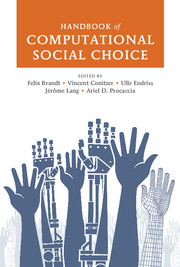1 - Introduction to Computational Social Choice
Published online by Cambridge University Press: 05 May 2016
Summary
Computational Social Choice at a Glance
Social choice theory is the field of scientific inquiry that studies the aggregation of individual preferences toward a collective choice. For example, social choice theorists— who hail from a range of different disciplines, including mathematics, economics, and political science—are interested in the design and theoretical evaluation of voting rules. Questions of social choice have stimulated intellectual thought for centuries. Over time, the topic has fascinated many a great mind, from the Marquis de Condorcet and Pierre-Simon de Laplace, through Charles Dodgson (better known as Lewis Carroll, the author of Alice in Wonderland), to Nobel laureates such as Kenneth Arrow, Amartya Sen, and Lloyd Shapley.
Computational social choice (COMSOC), by comparison, is a very young field that formed only in the early 2000s. There were, however, a few precursors. For instance, David Gale and Lloyd Shapley's algorithm for finding stable matchings between two groups of people with preferences over each other, dating back to 1962, truly had a computational flavor. And in the late 1980s, a series of papers by John Bartholdi, Craig Tovey, and Michael Trick showed that, on the one hand, computational complexity, as studied in theoretical computer science, can serve as a barrier against strategic manipulation in elections, but on the other hand, it can also prevent the efficient use of some voting rules altogether. Around the same time, a research group around Bernard Monjardet and Olivier Hudry also started to study the computational complexity of preference aggregation procedures.
Assessing the computational difficulty of determining the output of a voting rule, or of manipulating it, is a wonderful example of the importation of a concept from one field, theoretical computer science, to what at that time was still considered an entirely different one, social choice theory. It is this interdisciplinary view on collective decision making that defines computational social choice as a field. But, importantly, the contributions of computer science to social choice theory are not restricted to the design and analysis of algorithms for preexisting social choice problems. Rather, the arrival of computer science on the scene led researchers to revisit the old problem of social choice from scratch. It offered new perspectives, and it led to many new types of questions, thereby arguably contributing significantly to a revival of social choice theory as a whole.
Information
- Type
- Chapter
- Information
- Handbook of Computational Social Choice , pp. 1 - 20Publisher: Cambridge University PressPrint publication year: 2016
Accessibility standard: Unknown
Why this information is here
This section outlines the accessibility features of this content - including support for screen readers, full keyboard navigation and high-contrast display options. This may not be relevant for you.Accessibility Information
- 99
- Cited by
